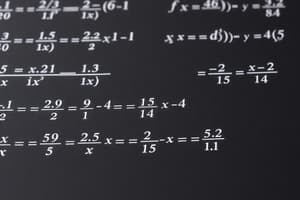Podcast
Questions and Answers
Which of the following is the quadratic equation in standard form?
Which of the following is the quadratic equation in standard form?
- $3x^2 + 5x + 2 = 0$
- $2x^2 - 3 = 0$
- $5x - 1 = 0$
- $4x^2 - 7x - 1 = 0$ (correct)
Which of the following represents the discriminant of a quadratic equation?
Which of the following represents the discriminant of a quadratic equation?
- $rac{-b ext{ plus or minus } ext{ square root of } (b^2 - 4ac)}{2a}$
- $rac{-b ext{ plus or minus } ext{ square root of } (b^2 - 4ac)}{a}$
- $b^2 - 4ac$ (correct)
- $rac{-b}{2a}$
What is the nature of the roots of a quadratic equation if the discriminant is zero?
What is the nature of the roots of a quadratic equation if the discriminant is zero?
- Real and equal (correct)
- Imaginary
- Complex conjugates
- Real and distinct
What is the sum of the first 10 terms of the arithmetic sequence $3, 7, 11, 15, ...$?
What is the sum of the first 10 terms of the arithmetic sequence $3, 7, 11, 15, ...$?
In a geometric series, if the first term is 5 and the common ratio is 2, what is the 8th term of the series?
In a geometric series, if the first term is 5 and the common ratio is 2, what is the 8th term of the series?
For the series $1 + 2 + 4 + 8 + ...$, what is the sum of the first 10 terms?
For the series $1 + 2 + 4 + 8 + ...$, what is the sum of the first 10 terms?
What is the sum of the first 10 terms of the geometric sequence $3, 6, 12, ...$?
What is the sum of the first 10 terms of the geometric sequence $3, 6, 12, ...$?
What is the 12th term of the arithmetic sequence $-3, 0, 3, 6, ...$?
What is the 12th term of the arithmetic sequence $-3, 0, 3, 6, ...$?
What is the nature of the roots of a quadratic equation if the discriminant is negative?
What is the nature of the roots of a quadratic equation if the discriminant is negative?
Flashcards are hidden until you start studying
Study Notes
Quadratic Equations
- The standard form of a quadratic equation is represented as ( ax^2 + bx + c = 0 ), where ( a, b, ) and ( c ) are constants and ( a \neq 0 ).
- The discriminant of a quadratic equation is calculated using the formula ( D = b^2 - 4ac ), which helps determine the nature of the roots.
Nature of Roots
- If the discriminant is zero (( D = 0 )), the quadratic equation has one repeated real root, indicating that both roots are the same.
- If the discriminant is negative (( D < 0 )), the quadratic equation has two complex roots, indicating that there are no real solutions.
Arithmetic Sequences
- The sum of the first 10 terms of the arithmetic sequence ( 3, 7, 11, 15, ... ) can be calculated using the formula ( S_n = \frac{n}{2} (2a + (n-1)d) ), where ( a ) is the first term, ( d ) is the common difference, and ( n ) is the number of terms.
- For the given sequence, the first term ( a = 3 ), common difference ( d = 4 ), and ( n = 10 ). The sum is ( S_{10} = 5(2 \cdot 3 + 9 \cdot 4) = 5(6 + 36) = 5 \cdot 42 = 210 ).
Geometric Sequences
- The 8th term of a geometric series with a first term of 5 and a common ratio of 2 is found using the formula ( a_n = ar^{n-1} ). Here, ( a = 5 ), ( r = 2 ), and ( n = 8 ), leading to ( a_8 = 5 \cdot 2^{8-1} = 5 \cdot 128 = 640 ).
- The sum of the first 10 terms of the geometric sequence ( 1 + 2 + 4 + 8 + ... ) can be calculated by the formula ( S_n = a \frac{1-r^n}{1-r} ) where ( a ) is the first term and ( r ) is the common ratio. Here, ( S_{10} = 1 \cdot \frac{1 - 2^{10}}{1 - 2} = \frac{1 - 1024}{-1} = 1023 ).
Additional Geometric Sequence Calculation
- The sum of the first 10 terms of the geometric sequence ( 3, 6, 12, ... ) uses the same formula, with ( a = 3 ), ( r = 2 ), and ( n = 10 ). Thus, ( S_{10} = 3 \cdot \frac{1 - 2^{10}}{1 - 2} = 3 \cdot \frac{1 - 1024}{-1} = 3 \cdot 1023 = 3069 ).
Arithmetic Sequence Term Calculation
- The 12th term of the arithmetic sequence ( -3, 0, 3, 6, ... ) can be determined with the formula ( a_n = a + (n-1)d ). For this sequence, ( a = -3 ), ( d = 3 ), and ( n = 12 ), resulting in ( a_{12} = -3 + (12-1) \cdot 3 = -3 + 33 = 30 ).
Studying That Suits You
Use AI to generate personalized quizzes and flashcards to suit your learning preferences.




